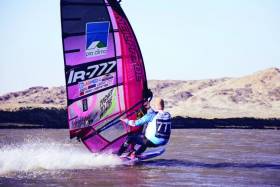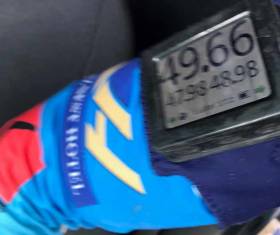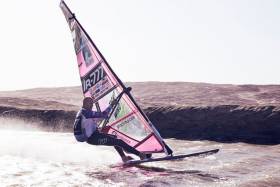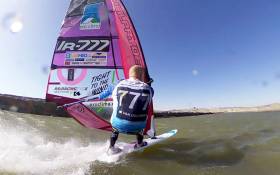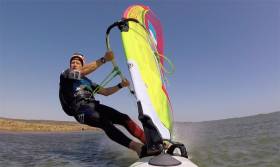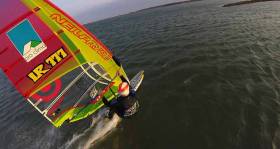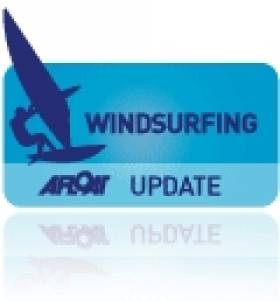Displaying items by tag: Oisin Van Gelderen
Dublin Speed Sailor Oisin van Gelderen Sets New Irish Sailing Speed Record in Namibia
Dublin Bay Windsurfer Oisín van Gelderen has broken his previous Irish Sailing Speed Record while participating at the 'Luderitz Speed Challenge in Namibia.
Van Gelderen is taking part in the World Record Attempt, and after three 'fruitless weeks' of moderate conditions, today the multiple Irish champion smashed his own personal best in winds gusting up to 62 knots. (Storm Force 10).
All speed sailing records are measured over a 500m course, and his aim at this event was to become the first Irish Sailor to hit 100 kmph, (54knots), and to improve his previous record and better 50 knots over the 500m course.
 Video time checked - official time 49.87 knots over 500m is Aa new Irish speed sailing record for Oisín van Gelderen
Video time checked - official time 49.87 knots over 500m is Aa new Irish speed sailing record for Oisín van Gelderen
Looking for an Elusive 50-Knot Record
Although he finished slightly shy of that mark at 49.87 knots (92.36kph) average over the 500m course, on Saturday the forecast promises to be even more suitable for attaining higher speeds, and he told Afloat he is more confident that the 'best is yet to come'.
"Right now the wind is a little broad, so we are sitting it out, but wind strength is perfect at 35 gusting 56 knots. My goal is to set a record above 50 knots over 500m, so still plenty to do"
All speeds are subject to final ratification by the WSSRC (World Sailing Speed Records Council).
Oisin Van Gelderen is Sailor of the Month (Speed Sailing) for November
The annual November visits of Skerries windsurfer Oisin van Gelderen to the Luderitz Speed Canal in the Namibian desert in southern Africa continue to fascinate Irish sailors as he battles to achieve a sustained speed above 50 knots. He has broken the 50 knots barrier in short bursts, and did it again in November 2019, briefly registering 51.7 knots. His GPS for the course showed 49.66 knots - still a third of a knot short of the magic 50, but he continues to be Ireland’s fastest sailor.
New Irish Speed Sailing Time Set at the Luderitz Speed Canal Subject to Ratification
There are unconfirmed reports coming from the Luderitz speed canal in Namibia that Irish Windsurfer Oisin Van Gelderen has broken the Irish speed sailing record time over 500m.
Van Gelderen has joined the fastest sailors in the world at this event to make an attempt at the Windsurfing World Record (53.27 knots / 98.6 kmph), currently held by French Sailor Antione Albeau.
Van Gelderen told Afloat: "My GPS shows 49.66 knots over 500m and my peak speed was 51.7knots but all record claims are subject to checking and ratification first".
As Afloat reported this time last year, the multiple times National Windsurfing Champion smashed the Irish Sailing Speed Record twice during his first two days competing at the 2018 Luderitz Speed Challenge.
The Luderitz course (a canal dug in a lagoon at the edge of the desert) has been specially designed to take advantage of the gale to storm-force winds common in this part of Africa.
Van Gelderen's goal is to become the first Irish Sailor to break the 50-knot barrier.
Oisin Van Gelderen is November “Sailor of the Month”
Oisin van Gelderen is the Afloat.ie/Irish Sailing “Sailor of the Month” for November after twice breaking the Irish sailing speed record at the three week Luderitz World Speed Sailing Challenge in Namibia.
The veteran National Windsurfing Champion from Loughshinny in Fingal opened the Luderitz series by pushing his own (and Ireland’s) best recorded speed up to 46.21 knots (85.6 kph) after briefly recording a 50-knot burst in Force 9 winds, the first Irish sailor ever to do so. But with even stronger winds as the series progressed, he finally came home with a new best Irish speed of 47.97 knots (88.85kph) over the timed distance of 500 metres.
Oisín van Gelderen is First Irish Sailor to Break 50-knot Speed Barrier
National Windsurfing Champion Oisín van Gelderen of Dublin has become the first ever Irish sailor to break the 50-knot speed barrier, during his final week competing at the Luderitz World Speed Sailing Challenge in Namibia, Africa.
As Afloat.ie previously reported, Van Gelderen joined the fastest sailors in the world for the last three weeks in Luderitz, with the aim of increasing his Irish Sailing Speed record (measured over 500m), and trying to break the elusive 50-knot barrier. The Luderitz course (a canal dug in a lagoon at the edge of the desert) has been specially designed to take advantage of the gale to storm force winds common in this part of Africa.
Van Gelderen significantly improved his record, on his second day at the event, in winds gusting 90 kph (Beaufort Force 9 - Strong to Severe Gale). But it wasn’t until this week that he reached his aim: he exceeded 50 knots, hit a high of 50.8knots (94kph), and set an official WSSRC ratified National record of 47.97 knots (88.85kph) over 500m.
Commenting on his achievements, Van Gelderen noted: "With the experience I have now gained, and the changes I made to technique and tuning, I know I could possibly do a 50knot 500m run, but for now I'm very happy. It's only with the experience of doing it, that I can work out what is possible. I have peaked seven times over 50 knots (50.8), achieved my goal of setting a respectable record, and I can leave Luderitz very proud, knowing I put everything into it."
National and World Sailing Speed Records are to be ratified by the WSSRC (World Sailing Speed Records Council), and are measured as an average speed over a 500m distance.
Windsurfer Oisín van Gelderen Smashes Irish Sailing Speed Record
Multiple times National Windsurfing Champion Oisín van Gelderen of Dublin has smashed the Irish Sailing Speed Record twice during his first two days competing at the 'Luderitz Speed Challenge' in Namibia, Africa.
Van Gelderen has joined the fastest sailors in the world at this event to make an attempt at the Windsurfing World Record (53.27 knots / 98.6 kmph), currently held by French Sailor Antione Albeau.
Van Gelderen’s top speed, of 46.21 knots (85.6 kph) average over 500m, was achieved on his second day participating at the event, in winds gusting 90 kph (Beaufort Force 9 - Strong to Severe Gale). The Luderitz course ( a canal dug in a lagoon at the edge of the desert) has been specially designed to take advantage of the gale to storm force winds common in this part of Africa.
Van Gelderen's goal is to become the first Irish Sailor to break the 50 knots barrier (93 kph), and set an official WSSRC Irish Sailing Speed Record over 50 knots.
The five-week event continues until 25th November, with the next strong to severe gale force winds forecast for later next week, when Van Gelderen expects to further improve his speed.
National and World Sailing Speed Records are to be ratified by the WSSRC (World Sailing Speed Records Council), and are measured as an average speed over a 500m distance.
Watch Windsurfer Oisín Van Gelderen Set Irish Speed Sailing Record
#SpeedRecord - Oisín van Gelderen has released an extended video of his Irish speed sailing record-setting run in the south of France last spring.
As previously reported on Afloat.ie, the windsurfer took to the lagoon at La Palme in the Occitanie region on 6 April 2017, after many days of waiting for the right conditions.
His new outright Irish speed sailing record of 42.16 knots over 500 metres was later ratified by the World Speed Sailing Record Council (WSSR), smashing the late John Kenny’s then longstanding record.
“All along it was my goal to try and break the 50 knot barrier (even as a VMax peak), and push my 500m speed (and the Irish record) up as close to 50 as I could,” he told Afloat.ie.
“Unfortunately the conditions didn't allow (wind not strong enough or at the wrong angle), and although the speed I set in La Palme broke my late friend John Kenny’s previous WSSRC 500m Irish Record by a couple of knots, ironically my own GPS Speeds are much faster.
Van Gelderen added: “I have national GPS Records too by GPS - which is much cheaper to do as I can concentrate on chasing the wind and finding the perfect location such as BunBeg in Donegal, or the Dungarvan Speed Strip at Abbeyside.
“But WSSRC 500m ratified speeds are still considered the ‘official’ national/world records.”
Afloat’s sailor of the month for September 2010 said that the current season has so far not been conducive to GPS speed sailing in Ireland.
“We have had plenty of wind, but never at the right angle - when the tide is also correct to give the right conditions.
“So for me the chase continues. and I will enter the two other WSSRC events this year – one again in the south of France at Le Rouet beach, and the second in Luderitz, Namibia."
Van Gelderen said he has tried to get to Namibia’s Skeleton Coast, where Paul Larsen set the outright record on Vestas Sailrocket 2 in 2012, for a number of years.
“It’s the ultimate course,” he says of the Luderitz Speed Challenge, “where all the world records and top 40 fastest speeds in the world come from.”
Afloat.ie wishes Oisín the best of luck in his efforts to make a mark for Ireland on the world speed sailing stage.
Oisin van Gelderen regained the Irish Speed Sailing title for windsurfing. The Dubliner achieved 44.16 knots in 77kph–winds yesterday following days of waiting for the correct conditions at the at the World Record Speed Challenge at Salin De Lapalme in Languedoc-Roussillon, France.
Van Gelderen's time has yet to be ratified by the World Speed Sailinng Record Council (WSSR) but he broke the late John Kenny's long standing record of 40.44 three times in the ideal conditions yesterday afternoon.
Windsurfer Oisín van Gelderen In Bid to Break World Speed Record
Multiple Irish Windsurfing Champion Oisín van Gelderen from Dublin joins the fastest windsurfers in the world, in a bid to break the Windsurfing Speed World Record, at a newly designed speed course at Salins De La Palme, in the south of France. The Irish GPS Speed Record Holder qualified for a wildcard invitation to the event, based on his previous speeds and potential to perform. Being invited to join the fastest windsurfers in the world at a specialised location, is the equivalent of being invited to play in the Croke Park Final, or the Golf Masters. He aims to use the opportunity to break his own personal best speeds and smash the 50knot barrier (92.6kph), and set a new official Irish Speed Record over 500merres - ratified by the WSSRC (World Sailing Speed Records Council).
The current windsurfing Speed World Record, held by Frenchman Antoine Albeau (France), stands at 53.27 knots (98.65kph) over 500 metres, which was set at purpose built speed canal in Luderitz, Namibia. This country is currently home to all the fastest speeds in the World - in both Windsurfing and Kitesurfing - and the Outright Sailing Speed World Record by Australian Sailor Paul Larsen (Aus), who in a custom build carbon fibre boat, blew everyone else away with a speed of 65.45 knots (121.21kph).
The La Palme course in France, is the brainchild of UK windsurfer Erik Beale, who in 1988 became the first sailor (of any kind) in history to break 40–knot barrier. With his vast experience, he sourced out potential locations that could provide world record breaking conditions, and found a location in France that could provide the essential combination of gale force wind and very flat water. The Tramontana wind howls offshore throughout this part of France, and the course itself is set in a salt marsh just inland of the Mediterranean, close to Leucate.
The world record challenge runs for seven weeks until the end of April, and Oisín's bid lasts for the first three weeks. To date, he has experienced moderate wind conditions for the start of the challenge, which has given good training runs but nothing near a record. For now, all the windsurfers wait for the Tramontana to properly show it's full force, and then the hope is that records will fall
Van Gelderen Claims New Irish GPS Speed Sailing Record
#SpeedSailing - Ireland may have a new speed sailing record after Oisin van Gelderen laid claim to a 46.67-knot run at West Kirby Marine Lake in northwest England yesterday (Wednesday 28 January).
The multiple-time national champion says the WGPSSRC, the governing body for GPS speed sailing records, is currently analysing the files from his two GPS units before ratifying the new record, which he set on the man-made lake in the Wirral in winds of up to 45 knots and amid "huge squalls in hail showers".
He explained of his chosen location: "When wind direction is correct (120-135 degrees off wind) we can sail extremely close to the wall of the lake to get flattest water, uninterrupted by the strength of the wind.
"Yesterday was one of those days, though the wind turned out a little too broad, making the water too choppy and ultimately slowing us down as there was not enough space to do longer runs, meaning crashing was a huge possibility."
Van Gelderen says one fellow speedster was hospitalised with suspected concussion and whiplash from crashing "into the water - not the wall".
The potential new record, representing van Gelderen's average speed over 10 seconds, beats his previous record of 45.02. He also says he upped his average of five fastest 10-second runs to 44.97 knots, and peaked at 47.3 knots. Details of his session are available HERE.
At time of writing, the record would put him fourth in the world for GPS speed sessions in 2015 - though the table is subject to change at any time as windsurfers from around the world contribute their data.
Van Gelderen also points out that the Irish record set by his late friend John Kenny and sanctioned by the WSSRC still stands.
But the Skerries windsurfer isn't resting on his laurels, aiming for an even stronger run at Bunbeg in Donegal, where he sailed last week.
"It has huge potential [for me] to go much faster," he says. "Fifty knots is in my sights."
Bunbeg GPS Speedsailing 11-1-15. Fast Course from IR 777 on Vimeo.


























